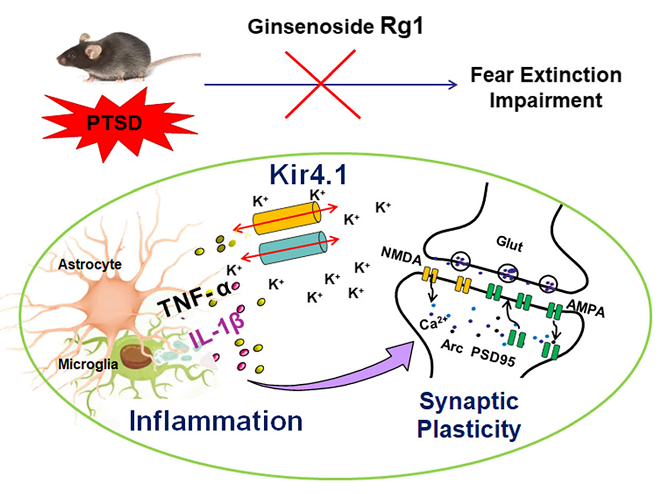AAV- shRNA Kir4.1 was used for knockdown of Kir4.1. (From
BrainVTA)
The viruses used in this article from BrainVTA are in the table below
|
Custom-Made AAVs |
AAV2/5-GFAP-EGFP-shRNA Kir4.1
AAV2/5-GFAP-EGFP-shRNA scramble |
Zhengrong Zhang, Zhujin Song, Fengming Shen, Pan Xie, Juan Wang, Ai-Song Zhu, Guoqi Zhu
Pub Date: 2020-11-19,
DOI: 10.1007/s12035-020-02213-9,
Email: sales@brainvta.com

Ginsenoside Rg1 is efficient to prevent or treat mental disorders. However, the mechanisms underlying the effects of ginsenoside Rg1 on post-traumatic stress disorder (PTSD) are still not known. In this study, single-prolonged stress (SPS) regime, as well as injection of lipopolysaccharide (LPS), was used to produce PTSD-like behaviors in C57 mice, and the effects of ginsenoside Rg1 (10, 20, 40 mg/kg/d, ip, for 14 days) on PTSD-like behaviors were evaluated. Our results showed that ginsenoside Rg1 promoted fear extinction and prevented depression-like behaviors in both LPS and SPS models. Importantly, ginsenoside Rg1 alleviated LPS- or SPS-stimulated expression of pro-inflammatory cytokines (IL-1β and TNF-α), activation of astrocytes and microglia, and reduction of hippocampal synaptic proteins (PSD95, Arc, and GluA1). Ginsenoside Rg1 also reduced the increase of hippocampal Kir4.1 and GluN2A induced by PTSD regime. Importantly, reducing hippocampal astroglial Kir4.1 expression promoted fear extinction and improved depression-like behaviors in LPS-treated mice. Additionally, intracerebroventricular injection of TNF-α caused an impairment of fear extinction and promoted Kir4.1 expression in the hippocampus. Together, our study reveals novel protective effects of ginsenoside Rg1 against PTSD-like behaviors in mice, likely via promoting synaptic proteins, reducing Kir4.1 and TNF-α in the hippocampus.
 Figure 1. Reducing Kir4.1 prevents PTSD-like behaviors in LPS-treated mice.
Figure 1. Reducing Kir4.1 prevents PTSD-like behaviors in LPS-treated mice.
This study is aimed to explore the mechanisms underlying the effects of ginsenoside Rg1 on post-traumatic stress disorder (PTSD). In this study, lipopolysaccharide (LPS)-treated and single-prolonged stress (SPS) mice models were utilized to evaluate the protection of Rg1 against PTSD-like behaviors and to assess the mechanisms. The results reveal novel protective effects of ginsenoside Rg1 against PTSD-like behaviors in mice, likely via promoting synaptic proteins, reducing Kir4.1 and TNF-α in the hippocampus.
BrainVTA offers viral vector construction & virus packaging services for AAV, LV, RABV, PRV, HSV and VSV that help researchers explore questions about genes, neurons, circuitry structure, function of brain network, mechanism and treatment of diseases.
If you have any needs, just email us at
sales@brainvta.com.

